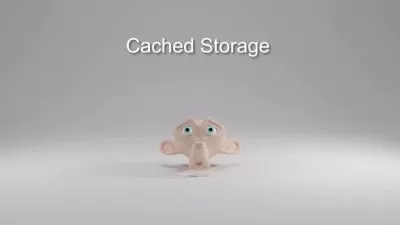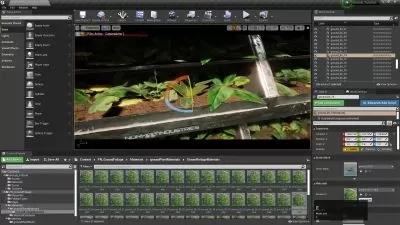Shader Magic in Blender (Ver 3.41 and above)
Joakim Tornhill
13:53:54
- Project files
- 3 - FlowMapPainter-0.9.2-win32.zip
- 3 - Images.zip
- 3 - NodeMaster-Blends.zip
- 3 - ReferencePatterns.zip
Description
More than just creating shapes! It's also about all the common techniques used in games!
What You'll Learn?
- The most common shader techniques used in games and some Blende specific things.
- How to work with the Blender Shader nodes
- How to create procedural shapes from scratch in Blender
- How Vector Math is working when creating Shaders.
Who is this for?
What You Need to Know?
More details
DescriptionAre you one of those that think that nodes look scary when you see a big node tree...or perhaps you are just curious how the water in a game can flow so nicely around those rocks in the river and follow the stream perfectly?
Regardless the reason, here is where you will learn more on how to connect those nodes!
I will go through how to create shapes, how Vector math works (like cross and dot product, Face forward, snap,...) and all the common techniques used in games like vertex painting, flowmap, parallax mapping, using a texture atlas/sprite sheet, Sobel (Edge detection on textures), trimsheet and so on.
I will also cover more "Blender specific"Â stuff like finding the edges on models, how to create scratches and dirt, creating procedural patterns using the radial gradient among other things.
You might wonder why in Blender and not in Unreal Engine or Unity?
Well, why not? Most things taught in the course can be used with only small adaptions in game engines as well. However, since we don't have all the whistles and extra stuff in Blender...you as a student are forced to learn the basics without cheating ;). I know from my own experience that it is a good path to walk if you really want to know how all things are put together.
The teacher you will get, me, has more than 10 years of experience of Blender, is educated as Technical Artist in one of the highest ranked 3D schools in the World;Â "The Game Assembly" and are currently working as a Technical Artist for the game "Midnight Ghost Hunt" in a Swedish Game Studio.
NB! You will however NOT learn about how to create realistic and nice materials. Those topics I cover in my course "Become a Material Guru in Blender". This course is Shader Magic.. not material magic :D.
Who this course is for:
- This is for all that want to go deeper in to the techniques used by Technical Artists in games to create shaders.
Are you one of those that think that nodes look scary when you see a big node tree...or perhaps you are just curious how the water in a game can flow so nicely around those rocks in the river and follow the stream perfectly?
Regardless the reason, here is where you will learn more on how to connect those nodes!
I will go through how to create shapes, how Vector math works (like cross and dot product, Face forward, snap,...) and all the common techniques used in games like vertex painting, flowmap, parallax mapping, using a texture atlas/sprite sheet, Sobel (Edge detection on textures), trimsheet and so on.
I will also cover more "Blender specific"Â stuff like finding the edges on models, how to create scratches and dirt, creating procedural patterns using the radial gradient among other things.
You might wonder why in Blender and not in Unreal Engine or Unity?
Well, why not? Most things taught in the course can be used with only small adaptions in game engines as well. However, since we don't have all the whistles and extra stuff in Blender...you as a student are forced to learn the basics without cheating ;). I know from my own experience that it is a good path to walk if you really want to know how all things are put together.
The teacher you will get, me, has more than 10 years of experience of Blender, is educated as Technical Artist in one of the highest ranked 3D schools in the World;Â "The Game Assembly" and are currently working as a Technical Artist for the game "Midnight Ghost Hunt" in a Swedish Game Studio.
NB! You will however NOT learn about how to create realistic and nice materials. Those topics I cover in my course "Become a Material Guru in Blender". This course is Shader Magic.. not material magic :D.
Who this course is for:
- This is for all that want to go deeper in to the techniques used by Technical Artists in games to create shaders.
User Reviews
Rating
Joakim Tornhill
Instructor's Courses
Udemy
View courses Udemy- language english
- Training sessions 65
- duration 13:53:54
- Release Date 2023/09/12









